I’ve been writing about wine for a long time now, and I’ve always been very hesitant to publish producer profiles. There’s no point in profiling a winery unless the writer regards those who run it as especially admirable, but open admiration can seem antithetical to critical independence. However, I figure I wouldn’t have lasted for nearly 30 years as a wine writer if readers didn’t find my evaluations trustworthy, so now the time has come to occasionally single out producers whose achievements are both extraordinary and also less well known than they deserve to be. That evaluation is easily merited by the achievements of the Elvio Cogno winery in Barolo, and of Nadia Cogno and her husband Valter Fissore, who have worked tirelessly and courageously to attain elite standing in one of the world’s premier wine regions.
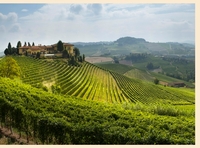
I first visited the Elvio Cogno estate in 2010, but had already written repeatedly about the striking Barolos being released from the Ravera vineyard, which was then considered just another mid-level growing site within the Barolo district. Nadia Cogno had evidently seen some of the reviews I’d written for The Washington Post and then here on Wine Review Online, as she mentioned my high regard for the Cogno releases from Ravera when I introduced myself to her (when visiting—on very short notice—with a handful of other journalists). She had done her homework, and that was an accurate indication of what I’d witness during the dozen ensuing years, which is that she and Valter are extremely hard workers. Their estate is now among the most beautiful, successful, and highly esteemed in Barolo, and yet Valter and Nadia still come off as workers much more than aristocrats.
I was fortunate to pay them a second visit on the last Friday in May of this year, having elected to stay around Alba for an extra day at the tail-end of a week of intensive study of the wines of the nearby Roero region (much more on that to come). Friday is a workday in the working-class world that I was born into, but when I arrived, only Nadia and Valter seemed to be on duty. Indeed, with a group of visitors due to arrive shortly after I showed up, the couple needed to divide duties, with Nadia hosting the group and Valter showing me all the current releases and then joining me for a relaxed lunch and an extremely interesting
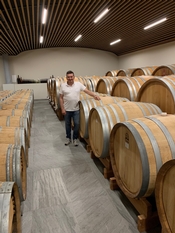
conversation up in the town of Novello. The idea of tacking an extra day onto that trip was one of the best decisions I’ve made in 2022.
The family’s history in wine is well told on the wine company’s website, elviocogno.com, so I need not reproduce the details here. The aspect that seems most remarkable to me is that everything has been accomplished so quickly—barely a generation and a half—that the word “history” is somewhat misleading.
Measured against the centuries-long histories of many important French producers making wine at a comparable level of quality, only a miniscule span of time has elapsed since Elvio Cogno took a giant risk and purchased the estate in 1990. It was then only a farmhouse with some surrounding vineyards, and he was a middle-aged man who had first been in the restaurant business before shifting to wine, working with the Marcarini family of La Morra. Virtually everything needed to be done to create cellars and shift to making fine wines from the estate. When Valter—who was educated and employed as an engineer—decided to join the enterprise, it was as big a leap for him as for Elvio. As he described the decision to me, “It was like seeing a train coming, and there’s only a minute to either get on or miss out.”
Valter and Nadia gradually took over management of the property and business, but worked with Elvio’s consultation until the family lost him in 2016 at the age of 79. Over that period of just 25 years, the estate was built up to become the most acclaimed producer in Novello. Since that time, it has been elevated into the very top rank of Barolo wineries, and established the Ravera MGA (or “cru”) on which it is located as one of the best growing sites in the entire appellation. Plots in Ravera were purchased by leading Barolo houses such as Vietti, Paolo Scavino and Vajra, which raises the question: What do you call an enterprise that is now being followed by leaders?
Despite these remarkable accomplishments, Valter remains very humble. Over the course of our conversation, he praised the contributions of both Elvio and Nadia with evident sincerity while also acknowledging that he’d made many mistakes along the way because of his restlessness and inclination toward experimentation. My impression is that his approach to both viticulture and winemaking is now more settled than in past years, but his drive to excel is obviously undiminished, and the result of all that experimentation is a lineup of wines that is extremely impressive in terms of its breadth as well as its depth of quality.
The current releases include wines from four different vineyard sources within the Ravera MGA, with different clones of Nebbiolo planted in different sites. If you add differences in vine age and variations in vinification techniques and aging regimens to this equation, you can probably sense the mind of someone trained in engineering at work. And yet, this rundown isn’t even finished with Nebbiolo yet, as the lineup includes a very fine
Barbaresco “Bordini” (2018 scored at
92 and 2019 at
93 points) and an entirely distinct
Langhe Nebbiolo “Montegrilli” that is focused on purity with no wood involved in its aging. I tasted the release from 2021 (
92), and it is already convincingly delicious and among the best wines of its type from anywhere around Alba.
Dolcetto and Barbera are also among the Elvio Cogno offerings, and though it is not uncommon for Barolo producers to work with these varieties as well as Nebbiolo, it is indeed uncommon to see them treated with such care and seriousness. The
Dolcetto “Mandorlo” is made without wood like the Langhe Nebbiolo “Montegrilli,” and also like that wine, the Dolcetto is already amazingly appealing from the 2021 vintage (
91—making me wonder how good the other wines from that year will be when ultimately released).
There are two bottlings of Barbera, and the
“Bricco dei Merli” is only “ordinary” by comparison to its stablemate, and is far above the regional average in terms of balance of fruit, acidity and wood. The 2020 is already seamlessly integrated and made in a style that will prove very versatile with food; I scored it at
92 in May. The
Barbera d'Alba "Pre-Phylloxera" is made from 100+ year-old vines from a plot near La Morra, and the 2020 rendition is ultra-silky in texture and remarkably “classy” in overall character, without the slightest hint of rusticity that I often find in Barbera. To be clear, I don’t object to that rustic edge when I find it, and think it makes this variety a good regional partner to Nebbiolo, which has an obviously “noble” character. However, this 2020 “Pre-Phylloxera” (
94) reminded me of an exemplary Côte-Rôtie more than a bottle of Barbera from anywhere in Piedmont. Already dangerously delicious at a very young age, I would guess that most bottles of this wine are enjoyed before they have time to develop fully, which would be an unfortunate result of a wine seeming fully complete within 18 months of when the grapes were picked.
Before turning to the four Barolo wines, the white
Langhe Nascetta DOC “Anas-Cëtta” is especially worthy of comment, as Valter was largely responsible
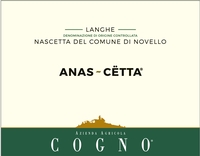
for bringing this variety back from extinction and earning DOC recognition for the category. It is probably native to the area and even to the specific commune of Novello, and the number of wines being produced is now up to 36 by my count, which is quite a revival, and one that is still gaining momentum. The first example I ever tasted was one offered at Cogno in 2010, and the 2021 vintage that I tasted in May (which was already assembled but not yet bottled) was the single best example I’ve ever experienced. The 2020 was also very good, and a bottle from the 2013 vintage that had been opened three days earlier was still quite interesting, with no negative oxidation.
Turning to the Barolo wines, the “entry level” release is
Barolo “Cascina Nuova,” made from the youngest plot of vines on the estate (which are now approaching 20 years of age, so not so young by any standard). The 2018 (
92 points) is especially impressive because the Barolo wines from this vintage are relatively soft, open, and easy to enjoy already, so if there was anything “unserious” about the “Cascina Nuova,” this is a growing season that would expose that shortcoming. As it turned out, the wine is showing very good structure and depth of flavor, with evident minerality and impressive overall complexity in light of its youth. The texture is soft and inviting, and at prices as low as $60, it offers excellent value.
Next up in my tasting in May was the
2018 Barolo Ravera release, which is made in roughly the same quantity as the Cascina Nuova but from much older vines of the Lampia and Michet clone of Nebbiolo. Aged in large Slavonian oak casks, it is a highly complex and age-worthy wine, and the 2018 (
95 points) is phenomenally detailed and yet still easy to enjoy even at this early stage in its development. That’s partly a result of the growing season, but also the old vines and the absence of overt barrique woodiness or the effects of an overly aggressive maceration regime. This has a natural “ease” and charm to it in 2018, and is among the very best wines I’ve tasted from the vintage. Delicious now but surely delicious 15 years from now, this is impressive without trying too hard.
Third was
Barolo Ravera “Bricco Pernice” 2017 (
96 points), which is made entirely from the Lampia clone of Nebbiolo and shows a lot of firm tannins in this vintage. However, the wine is still very appealing even at this early stage of development, with lovely aromas and flavors that show excellent detail. The fruit is open and inviting when first tasted, and the midpalate is also extremely appealing before the tannins begin to show their grip in the wine’s finish. The 2017 growing season was not an easy one, and had an almost impossible act to follow when succeeding the historically outstanding 2016 vintage, and yet this wine shows great skill and promises a long and illustrious finish.
Last up was the
2016 Barolo Ravera “Vigna Elena” Riserva, a wine of great beauty and intricacy that I may very well have underscored at
98 points. It is made entirely from the Rosé sub-variety of Nebbiolo, and is a wine of great
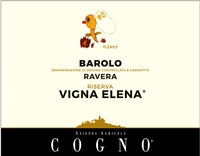
subtlety and elegance. Delicate floral aromas are entrancing, and the flavors combine gorgeously pure fruit with a wealth of savory accents. Its combination of striking expressiveness without any excess palate weight makes a comparison to Grand Cru Burgundy appropriate, though of course that’s just a stylistic similarity rather than a compliment, as the best examples of Barolo are equal to the best renditions of red Burgundy. Every element in this wine—fruit, acidity, tannin and wood—seems so finely proportioned that no element intrudes on the others. This is one of those rare wines that seems like it couldn’t be improved if any of its aspects were either amplified or toned down, which is why I worry a bit that my score is too low. But time will tell, and I’ll be delighted to correct my error if the future proves that I missed on the low side.
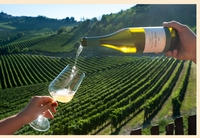
I fully expect to visit this great estate again before long, and won’t let 12 years elapse between visits ever again. If you are fortunate to travel to the region, this is a winery that should be near the very top of your “visit wish list,” but if you’ll need to content yourself with tasting the wines from wherever you live, you’ll find them richly rewarding.